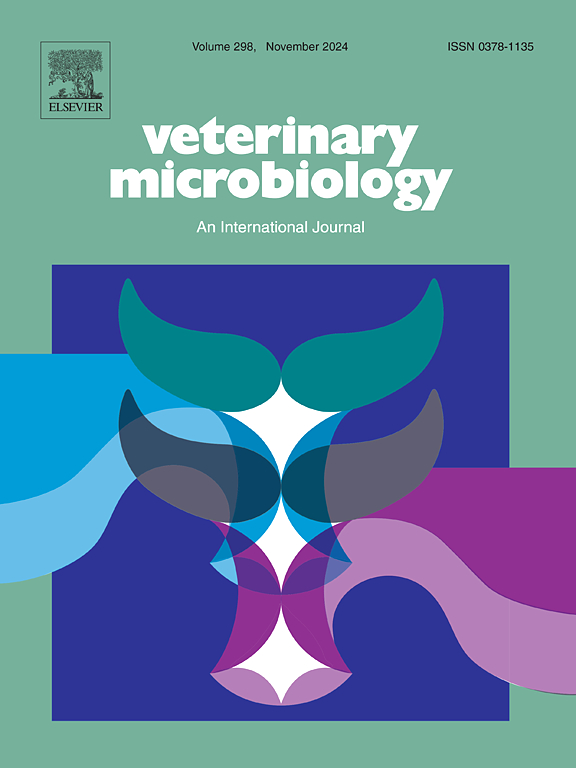西班牙南部野生鸟类中再次出现巴加扎病毒。
IF 2.4
2区 农林科学
Q3 MICROBIOLOGY
引用次数: 0
摘要
巴加扎病毒(BAGV;Orthoflavivirus bagazaense)是一种新出现的影响禽类物种的病媒黄病毒,对动物健康有严重影响,也有研究认为它有可能成为人畜共患病。本研究的目的是监测 2021 年在西班牙野鸟中爆发的 BAGV 流行病。24 个狩猎区的野禽物种(包括红腿鹧鸪(Alectoris rufa)和普通雉鸡(Phasianus colchicus))均确诊了 BAGV 病例。在另外 11 个狩猎区也发现了疑似病例(临床症状和/或死亡率与 BAGV 感染相符,但未经分子确认)。疫情主要集中在 7 月和 8 月。在受影响的狩猎区发现了估计发病率[鹧鸪为 25.8 %(95 %CI:11.3-40.3),雉鸡为 8.7 %(95 %CI:0.0-18.0)]和死亡率[鹧鸪为 27.3 %(95 %CI:12.5-42.1),雉鸡为 13.0 %(95 %CI:1.9-24.1)]。此外,在 2021 年期间,通过被动监测,对进入康复中心的 46 个不同物种的 215 只非野禽进行了采样。在绿啄木鸟(Picus viridis)、琵鹭(Platalea leucorodia)、白鹳(Ciconia ciconia)和秃鹫(Aegypius monachus)中首次检测到BAGV感染,扩大了这一新兴病原体的宿主范围。与其他物种不同的是,野禽表现出明显的 BAGV 相关病变,主要是心肌炎和脑炎,此外还有肝脏和肾脏的炎症浸润和坏死。分子分析表明,本研究中获得的 BAGV 序列(492 bp)与 2010 年和 2019 年在西班牙南部分离到的 BAGV 序列之间的同源性分别为 97.4-98.0 % 和 92.5-92.7 %。根据这些结果,我们可以推测自 2010 年以来,BAGV 病毒很可能在这一欧洲地区静默流行,但也不能排除病毒从邻近地区再次传入的可能性。我们的研究结果证明了再次出现的 BAGV 对野生鸟类的卫生、生态和保护的影响,同时也强调了在高风险地区加强监测和早期发现黄病毒动态的必要性。本文章由计算机程序翻译,如有差异,请以英文原文为准。
Re-emergence of Bagaza virus in wild birds from southern Spain
Bagaza virus (BAGV; Orthoflavivirus bagazaense) is an emerging vector-borne flavivirus affecting avian species with severe implications for animal health, and whose zoonotic potential has also been suggested. The aim of the present study was to monitor the epidemic outbreak of BAGV in wild birds from Spain in 2021. BAGV cases were confirmed in game bird species, including red-legged partridges (Alectoris rufa) and common pheasants (Phasianus colchicus) from 24 hunting areas. Suspected cases (clinical signs and/or mortality compatible with BAGV infection but without molecular confirmation) were also detected in 11 additional hunting areas. The outbreaks showed a seasonality mainly restricted to July and August. Estimated morbidity [25.8 % (95 %CI: 11.3–40.3) in partridges and 8.7 % (95 %CI: 0.0–18.0) in pheasants] and mortality rates [27.3 % (95 %CI: 12.5–42.1) in partridges and 13.0 % (95 %CI: 1.9–24.1) in pheasants] were found in the affected hunting areas. In addition, 215 non-game birds belonging to 46 different species were sampled by passive surveillance upon admittance to rehabilitation centres during 2021. BAGV infection was detected for the first time in green woodpecker (Picus viridis), spoonbill (Platalea leucorodia), white stork (Ciconia ciconia) and cynereous vulture (Aegypius monachus), expanding the host range of this emerging pathogen. In contrast to other species, game birds showed distinct BAGV related lesions, primarily myocarditis and encephalitis in addition to inflammatory infiltrates and necrosis in the liver and kidney. Molecular analyses revealed a homology of 97.4–98.0 % and 92.5–92.7 % between the BAGV sequences obtained in the present study (492 bp) and those isolated in 2010 and 2019 in southern Spain, respectively. These results allow to hypothesise about the likely silent and endemic circulation of BAGV since 2010 in this European region, although repeated virus reintroduction from neighbouring territories cannot be ruled out. Our findings evidence the sanitary, ecological and conservation implications of the re-emerged BAGV for wild birds, also emphasising the need to increase surveillance for monitoring and early detection of flavivirus dynamics in high-risk areas.
求助全文
通过发布文献求助,成功后即可免费获取论文全文。
去求助
来源期刊

Veterinary microbiology
农林科学-兽医学
CiteScore
5.90
自引率
6.10%
发文量
221
审稿时长
52 days
期刊介绍:
Veterinary Microbiology is concerned with microbial (bacterial, fungal, viral) diseases of domesticated vertebrate animals (livestock, companion animals, fur-bearing animals, game, poultry, fish) that supply food, other useful products or companionship. In addition, Microbial diseases of wild animals living in captivity, or as members of the feral fauna will also be considered if the infections are of interest because of their interrelation with humans (zoonoses) and/or domestic animals. Studies of antimicrobial resistance are also included, provided that the results represent a substantial advance in knowledge. Authors are strongly encouraged to read - prior to submission - the Editorials (''Scope or cope'' and ''Scope or cope II'') published previously in the journal. The Editors reserve the right to suggest submission to another journal for those papers which they feel would be more appropriate for consideration by that journal.
Original research papers of high quality and novelty on aspects of control, host response, molecular biology, pathogenesis, prevention, and treatment of microbial diseases of animals are published. Papers dealing primarily with immunology, epidemiology, molecular biology and antiviral or microbial agents will only be considered if they demonstrate a clear impact on a disease. Papers focusing solely on diagnostic techniques (such as another PCR protocol or ELISA) will not be published - focus should be on a microorganism and not on a particular technique. Papers only reporting microbial sequences, transcriptomics data, or proteomics data will not be considered unless the results represent a substantial advance in knowledge.
Drug trial papers will be considered if they have general application or significance. Papers on the identification of microorganisms will also be considered, but detailed taxonomic studies do not fall within the scope of the journal. Case reports will not be published, unless they have general application or contain novel aspects. Papers of geographically limited interest, which repeat what had been established elsewhere will not be considered. The readership of the journal is global.
 求助内容:
求助内容: 应助结果提醒方式:
应助结果提醒方式:


